
Sport Imagery Questionnaire of Hall et al.(1998) was developed to investigate the imagery type of athletes objectively. The purpose of this research is to verify validity and reliability of Korean SIQ by using Rasch Model, in order to make up for complement drawback of SIQ which was developed only using factorial analysis. This research conducted first and second questionnaire survey. Second survey was conducted targeting different study participants from those of first survey. The participants of first survey was 265 athletes of Chungcheong Province, and the participants of second survey was 169 athletes of Chungcheong Province. SPSS 21, Winstep 3.62, and AMOS 18 was used for date analysis. The result of Rasch Model verification for the data of first survey revealed that 8 items of SIQ were unfit. Thus, 5 factors and 22 items were determined. 7 point Likert scale was revealed to be a good fit. The result of Confirmatory Factor Analysis for the data of second survey revealed that Construct Validity of 5 factors and 22 items was valid and reliability was high by recording Cronbach’α value .954. External Validity was revealed to be high by showing that correlation between sport confidence and MG-M imagery was high.

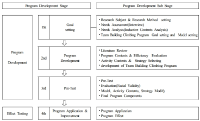
The purpose of this study was to examine the effects of team building climbing program on happiness, social development, self-esteem, stress, and depression of the youth. The participants consisted of 27 university students. The self-report instruments were compose of happiness scale, social development inventory, self-esteem scale, stress inventory, and depression scale. Qualitative data were participants’ perception about the effects of team building climbing program. Firstly, team building climbing program had positive effect on happiness of the youth, while climbing program had not significant effect on happiness of the youth. Secondly, both team building climbing program and climbing program had positive effect on social development of the youth, while team building climbing program was significant higher than climbing program in post-time. Thirdly, team building climbing program had positive effect on stress of the youth, while climbing program had not significant effect on stress of the youth. Fourthly, both team building climbing program and climbing program had positive effect on self esteem of the youth, while there were not significant between team building climbing program and climbing program in self esteem of post-time. Fifthly, both team building climbing program and climbing program had positive effect on depression of the youth, while there were not significant between team building climbing program and climbing program in depression of post-time. Limitations of this study and future implications were discussed.


Purpose This study was to examine the effect of athletes’ personality on coach-athlete maintenance of relationship. Methods For this purpose, the data was collected by 284 athletes using personality five factor questionnaire and Coach-Athlete Relationship Maintenance Questionnaire(CARM-Q). correlation and multiple regression analysis were conducted to verify the relationship between five personality factors and maintaining coach-athlete relationship. Results The results were as follows: Personality had a significant effect on the maintenance of coach-athlete’s relationship. Firstly, the artificial neural network was analyzed to find the influence of personality that determine positive relationships with coaches. Conclusion As a result, it was confirmed that the favor was the main discriminant factor in maintaining the relationship of coach-athlete. Finally, openness and sincerity were found to maintain and develop the positive relationship with coaches.

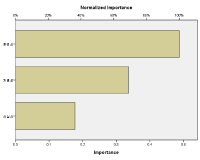
PURPOSE This study developed and tested a theoretical research model delineating the relationships between sports consumers’ team identity and their response to regional identity, sense of community, and community contributions. METHODS To achieve the purpose of this study, a total of 1,196 spectators who attended professional baseball games were surveyed. For the data analysis, confirmatory factor analysis, convergent validity, discriminate validity, and composite reliability were performed to confirm the validity and reliability of the scale through AMOS 24.0. Research model and hypothesis testing were conducted using structural equation modeling, which used data from ten different professional baseball team area contexts. RESULTS The results provide empirical evidence of the positive influence of sports consumers’ regional identity and sense of community on team identity toward community contributions in sporting event area contexts. CONCLUSIONS This study confirmed the role of regional identity and sense of community in building professional sports team identities and community contributions.
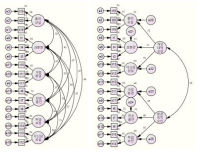
This study was to identify the structure of sports drop-out of athletes considering cognition, emotion and situational motivation, and to develop the measurement of sport drop-out motivation. For this, the validity of internal structure and relationship with overall drop-out intention were examined by targeting 689 individuals and team athletes. The results were as follows: Sports drop-out motivation was verified two hierarchical structure. One is individual internal factor including loss of interest, overtraining, loss of confidence, the other is environmental external factor including home environment, career anxiety, academic slump. The female players have higher drop-out motivation level than male players, and the drop-out motivation was shown the difference by level of school. Also, loss of interest and confidence weres to predict overall drop-out intention well. Therefore, this study was found this measurement was able to reliably predict drop-out motivation among players.

PURPOSE This study aimed to analyze factors associated with physical activity (PA) in older adults based on social ecological theory. METHODS Secondary analysis was conducted using raw data from the 2021 Community Health Survey. after excluding 129 non-responses in the PA domain, a total of 74,363 individuals were included in the final analysis. A total of eight factors, including personal (level of depression, history of falls), relational (relationships with neighbors, living alone), community (satisfaction with the local community system, safety), and environmental factors (living environment, natural environment), were selected in accordance with the key points of social ecological theory. To analyze social ecological factors related to the PA of older adults, we conducted a decision tree analysis using Chi-square automatic interaction detection (CHAID). RESULTS The average PA level among older adults was approximately 136 minutes, but the mode and median were both 0 minutes. A total of 20.2% of older adults met the physical activity recommendations, while 79.8% did not. According to the first split of the decision tree, living alone was the most relevant factor associated with the PA of older adults, followed by depression and falls. Older adults living alone, with a depression score of 10 or higher, and who had experienced a fall within the past year, were least likely to meet the PA recommendations. CONCLUSIONS This study urgently suggests that PA programs should target older adults living alone, experiencing depression, and falls.
PURPOSE This study investigated the associations between physical fitness and fall efficacy with thigh circumference in elderly women with osteopenia/osteoporosis. METHODS A total of 166 female participants aged 76.3±5.0 years with –1.0≥T-score of femur neck bone mineral density were voluntarily recruited from local community centers. The participants were classified as low 25%, middle 50%, and high 25% groups based on their thigh circumference. Physical fitness measurements, including strength, flexibility, aerobic endurance, and balance were measured with a standardized protocol. The Korean version of the fall efficacy scale (K-FES) was used to assess fall efficacy. Logistic regression analysis was used to estimate odd ratio (OR) of poor physical fitness and low fall efficacy according to thigh circumference levels. RESULTS In terms of physical fitness, the middle 50% group (OR=0.430, 95% CI=0.194-0.953) and high 25% group (OR=0.129, 95% CI=0.049-0.343) had significantly higher linear trend for poor physical fitness compared to the low 25% group (reference), (p<0.001). In fall efficacy, the middle 50% group (OR=0.279, 95% CI=0.119-0.656) and high 25% group (OR=0.100, 95% CI=0.036-0.275) had significantly higher linear trend for low fall efficacy compared to the low 25% group (reference) (p<0.001). CONCLUSIONS The current findings suggest that maintaining high thigh circumference via regular physical activity and diet may contribute to attenuation of decreased risk for poor physical fitness and low fall efficacy in elderly women with osteopenia/osteoporosis.
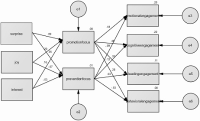
Purpose The purpose of this study was to find out the relationship between emotion and control focus and training involvement in games where elite shooters are late. Methods Thus, 228 elite shooters were selected and the research results were derived based on data analysis using discriminatory emotions, control focus, and training attendance scales. Results According to the analysis of the correlation between emotion, control focus, and training involvement, positive emotions of surprise, enjoyment, and interest showed a static relationship with improvement focus and training involvement, while negative emotions such as anger and guilt had a static relationship with prevention focus, but showed an inadequate relationship with training involvement. The multiple regression analysis between emotion and control focus showed that the improvement focus showed the most significant effect of enjoyment emotion, while the prevention focus showed that instability had the most effect on the prevention focus. Overall, the focus of improvement has been shown to be affected by training. Finally, it was found that positive sentiment had a positive effect on improvement focus and training involvement, while negative sentiment affected prevention focus and reduced cognitive involvement. Conclusions Positive sentiment toward the competition has been confirmed to enhance training participation by strengthening the focus of improvement, but negative sentiment has been shown to enhance the focus of prevention, reducing cognitive involvement.

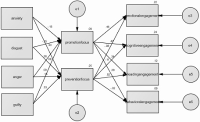
Purpose The purpose of this study was to investigate the relationship between physical activity and depression according to the presence of disease. Methods A survey and basic assessment were conducted for 2,754 (Male=1,025 and Female=1,729) aged 40 and over who participated in the rural-based cohort study. The survey included physical activity, depression scale and disease preservation. The basic assessment measured height, weight, and body fat percentage. The measured data were analyzed by using logistic regression to examine the relationship between physical activity and depression prevalence. Results First, physical activity reduced the prevalence of depression by 33% and 51%, respectively, in the general population and in patients with the disease. Second, physical activity once or twice per week reduced the prevalence of depression in patients with disease by 51%, and at least three physical activities reduced the prevalence of depression by 37% in the general population and 33% of patients with disease. Third, physical activity less than 150 minutes per week reduced the prevalence of depression in patients with disease by 43%, and physical activity of more than 150 minutes and less than 300 minutes per week reduced the prevalence of 43% of the general population and 52% of patients with disease. Physical activity over 300 minutes per week had a 38% reduction in the prevalence of depression in the general population. Conclusions This study suggests that the level of physical activity suggested by the ACSM guidelines is appropriate to reduce the prevalence of depression. In addition, the patients with the disease was found to be effective with less frequency and amount of physical activity than the general person.
This study was to explore the factors influencing Olympic performance positively and negatively. In order to achieve this purpose, 60 athletes, who participated in 2012 London Olympic games, responded on open-ended questionnaire. In addition, 10 athletes, who won medals in London Olympic, responded on in-depth interview. Collected data were analyzed by deductive content analysis. The results of this study were as follows: firstly, the factors influencing Olympic performance positively were psychological preparation, strengthening training, physical conditioning, support from significant others, material support, cheering of Korean people, self respect as a Korean national athlete, different game environment, team cohesion, sharing Olympic experience, and support of sports science. Secondly, the factors influencing Olympic performance negatively were psychological pressure, excessive expectation, negative interpersonal relationship, condition decline, overtraining, unstable environment, insufficient facilitation, decrease in performance level, and especially ineffective village room placement and media management during Olympic period. Thirdly, the differences between Olympic games and other world competitions , perceived by athletes were competition scale, psychological attitude, training support, systematic preparation, and benefits from winning medals. The results of this study will give fundamental information in developing a scale which can measure Olympic preparation level and in developing Olympic preparation guideline. Therefore, it will help athletes ,who participate Olympic for the first time or athletes who did not perform well in pre-participated Olympic games, to understand and apply in training the factors influencing Olympic performance and help them to perform better in Olympic games.